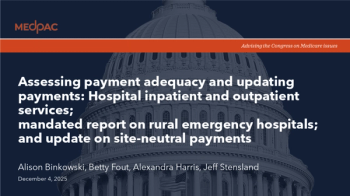
Top 6 things physicians need to know about MACRA, Obamacare repeal
It was a confusing week for physicians to figure out proposed MACRA rules and dissect the Republican plan to dismantle Obamacare. Let me help make sense of them both.
Editor’s Note:
Confusion reigns after a week that saw the release of the proposed 2018 rule for the law governing Medicare payment to physicians, known as
Further reading:
Condemnation of the BCRA is near unanimous the best I can tell. Republicans find the bill to be either not conservative enough, or too conservative and the Democrats have declared the bill poison sure to rival wars in the deaths it will cause.
Anish Koka
It doesn't help that non-partisan analyses are difficult to find for the hapless physician who simply wants to know how this affects us and our patients, and by extension, our livelihoods. What follows are my best attempt to answer some important questions for fellow practicing physicians.
1. Are there any fundamental changes to MACRA under a new administration (i.e. Health and Human Services Secretary Tom Price and Seema Verma, head of the Centers for Medicare & Medicaid Services)?
Sadly, the current administration's version of MACRA reads like it was written by the prior administration. The cat-and-mouse game between Medicare and its physicians is very much alive and well.
Avoiding a penalty in 2019 requires enrolling individually in the Merit-based Incentive Payment System (MIPS) or being a part of an Alternative Payment Model (APM). The MIPS track, as before, involves scoring points to provide value by reporting on quality measures. In the current year, a penalty may be avoided in 2019 by reporting on one quality measure for one patient to nudge physicians onto the value-based hamster wheel. There are some wrinkles to the proposed plan for 2018 (affecting 2020 payments).
Even more info:
The most significant is raising the low-volume threshold to $90,000 or less for Medicare Part B charges or 200 or fewer Medicare patients annually. The prior threshold was $30,000 or 100 Medicare patients. Surprisingly, only 36% of eligible clinicians cross this new threshold - though they do make up almost 60% of Part B charges. Other changes relate to bonus points for complex patients, reporting in virtual groups and easing requirements for the use of 2015 certified electronic health record (EHR) technology. In the end, these changes are not nearly enough to ease the stifling regulatory environment the current value-based regime finds itself enamored with. It puts small physician groups at a disadvantage.
2. Who does the BCRA impact?
The BCRA is designed to impact patients not covered by Medicare or employer-sponsored group insurance. Currently this group is divided between Medicaid patients, those on the individual marketplace and those that are still uninsured.
3. How do patients get healthcare coverage under the BCRA?
The Affordable Care Act (ACA) instituted an individual mandate that-under threat of financial penalty-required patients to sign up for insurance through the Obamacare insurance marketplace. Generous subsidies to insurance companies kicked in for those making <400% of the federal poverty line (FPL).
In case you missed it:
The proponents of the BCRA envision a world where patients may choose to have health savings accounts (HSAs) funded by tax-free credits that they can use to buy insurance on the individual market. Subsidies based on age and income (less generous than the ACA) kick in at less than 350% of the FPL. The GOP has replaced the individual mandate with a penalty of its own: a freeze of six months for getting insurance for those who did not maintain continuous coverage the year before.
4. Will the BRCA be more affordable for patients?
The New York Times recently ran
Blog:
A recurring, and understandable concern, is where individuals and families with meager resources actually will get the dollars to fund HSAs or pay for care that falls under a high-deductible plan. Tax credits are a nice idea, but you need income to be able to put money into a tax free account. The GOP solution relies on the allocation of $110 billion to the State Stability and Innovation Program that is specifically meant to “Reduce out-of-pocket costs, such as copayments, coinsurance and deductibles, of individuals enrolled in plans offered in the individual market.” There is active debate about whether this is enough money, but consider that the total amount of money allocated for cost sharing subsidies (now repealed) in the ACA was $105 billion.
5. What is the effect of reducing essential health benefits (EHBs) to patients?
The intent of weakening essential health benefits was to allow for skinnier plans that would cost less. What exactly will be covered under your plan is unclear as there seems to be latitude given to states to decide on minimum health benefits (though certain popular aspects of the ACA like children being covered until age 26 were left in place). Democrats are fearful that patients may be preyed upon by insurance companies that offer plans that don't actually pay for anything. This is mildly amusing as the weighty ACA plan that I currently have pays for mental health as it is mandated to do, but leaves me with hundreds of dollars to pay for routine labs because of a high deductible.
6. Does this bill degrade the safety net for Americans?
Reasonable people can come to different conclusions about this question. The BCRA does attempt to bend the cost curve by extracting savings from Medicaid. If all one hopes to do is to take the current system and extract dollars from it, there is little question that services will be degraded.
Hot topic:
What is unknown, however, is if the plan to convert Medicaid to a tax credit-based system that patients can use to spend on healthcare, along with cost-sharing support for those under 350% of the Federal Poverty line will actually work. Conservatives believe, and I'm partial to the idea, that giving patients healthcare dollars directly will make them just as resistant to buying a $1,000 bag of salt water as they would be to buying a $1,000 flip phone.
Billions of dollars do flow to the truly disabled within the Medicaid program and much of the hand wringing understandably relates to cuts to services for this population. Giving states flexibility under block-grant federal funds, and capping what the federal government can spend (as opposed to the unlimited federal match states enjoy right now for each additional patient enrolled) could theoretically lead to poorer services for several patients, including the severely disabled. I find it hard to believe, though, that any politician with an interest in getting reelected would choose to do this. It is much more likely that states would go after low hanging fruit like fraud and waste, and look to incentivize able bodied patients to get off Medicaid so states could continue to pay for those who most need it.
Anish Koka is a cardiologist in private practice in Philadelphia trying not to read the writing on the wall. Follow him on twitter @anish_koka.
Newsletter
Stay informed and empowered with Medical Economics enewsletter, delivering expert insights, financial strategies, practice management tips and technology trends — tailored for today’s physicians.
















